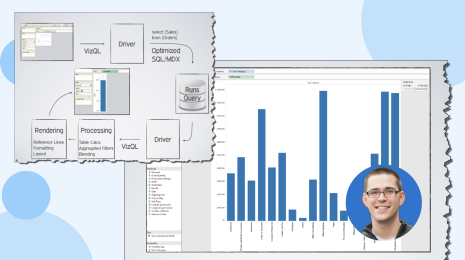A reflection on responsibly applying AI
Originally posted on LinkedIn.
AI remains a widely-debated topic with technologists and brands. Many of us, Tableau included, are gauging the full potential AI and machine learning will have on products in the future. I’ve appreciated hearing from technology leaders like Kris Miller, Chief Strategy Officer at eBay, who talked about using AI techniques to improve search, through understanding the data collected from images. Or Jeetu Patel, Chief Product Officer at Box, who spoke about applying algorithms to content to make it more valuable inside Box, but also about the impacts that these algorithms have on product release cycles. These are just two of many stories told about how these techniques are adding value to companies.
These and other stories also underscored that AI is a double-edged sword. On one hand, we know that these techniques can add considerable value to products. They offer personalization; connecting people with the right content, augmenting or extracting information from content, and letting businesses figure out what opportunities to spend time on. And in a world where companies serve millions of customers, all of these are required for scale.
But on the other hand, it also puts ethics front-and-center for companies. Ethics and transparency have to be equally prioritized with the automation and efficiency goals we normally think about. And we have to think about the role of bias factoring into human and artificial intelligence—another topic discussed by attendees and widely covered by media outlets like Fast Company, PC Magazine, and Forbes, to name a few.
What struck me is that we’re all on different journeys with similar objectives. We’re all figuring out how to effectively and responsibly apply AI techniques to enhance our business intelligence and make sense of the overwhelming amounts of data available to us. It’s about finding the business problems that can be solved through the application of smart algorithms to data, and in a way that’s beneficial to the world around us.
Don’t be an AI creep. Here’s how to responsibly apply AI to today’s technology.
If you keep in mind these considerations when applying AI to your technologies, the road ahead will be smoother. Blending what human intelligence and machine intelligence do well is an important part of that journey.
- Build trust and transparency. The worst thing a brand can do to damage reputation is create trust issues. While it seems that many consumers will cede rights to their data to use a popular service, enterprises certainly won’t. Consider the data you’re collecting and whether your customers would take issue with its use. Some may defend their AI by pointing to open-source algorithms available to everyone, but that isn’t enough because those algorithms aren’t understandable by most. Clearly explaining what you’re doing with AI and the data helps maintain consumer, partner, and industry trust and loyalty.
- Remember, AI isn’t magic—it’s math. For those knee-deep in it, they can attest it’s very hard math with complexities and considerations to the formula that evolve as data changes. Our outputs are only as good as our inputs, and one of those inputs is the team that creates it. If technology is developed by a homogenous group, it can be biased because perspectives are missed. And we keep hearing of bias working its way into technology. PC Magazine reported racist and sexist tendencies in popular chatbots. Bari Williams has talked about predictive policing algorithms based on data from over-policed communities, and how those algorithms then reinforce the biases of the manual system. These examples contradict the conventional wisdom some hold that AI doesn't suffer from the gender, racial, and cultural prejudices that humans do.
To my earlier point, we need to be vigilant in bringing transparency and careful about the information on which we base AI techniques. And we need to acknowledge our role in propagating human biases and work to undo their effects.
- Know what AI doesn’t know. There is still plenty that AI doesn’t know and may never know. For instance, only people can determine if answers provided by technology satisfies the problem they are trying to solve, so the humans in the system have to evaluate if the problems are being solved correctly. There is also continued white space to explore around how people use AI, what data they have, and how human and machine intelligence will work together to solve the data problems of today and the future. One thing’s for certain: The roles that will remain secure will be those who fine-tune the machines’ moral compasses.
Tableau’s journey with AI—what we’ve learned along the way
I appreciated having time to pause and absorb a diverse set of AI perspectives as Tableau invests in smart technologies that augment human ability to see and understand data. We take our responsibilities very seriously when bringing machine learning and AI into the Tableau platform so taking time to hear, learn, and decide the path forward while embracing these smart technologies is top of mind for me and my team.
As we’ve seen with Tableau adoption and now with AI, having support to do things more efficiently or even better is a valuable benefit and a worthwhile reason to embrace these disruptive technologies. Our priority will remain connecting human intuition and curiosity with the power of the machine by infusing smart, augmented capabilities like NLP that make analytics easier and more accessible to everyone.
Last year, we launched our smart recommendation engine as we applied algorithms so Tableau can recommend which are the best, certified data sources and table joins based on the most used and appropriate to what you're trying to accomplish. We've also accelerated our NLP work to bring Tableau to the masses in a more accessible and natural way. We'll showcase our NLP work later this year so be on the lookout for more information shared through our website or LinkedIn.
Continuing the AI dialogue is important as new innovations emerge and players come on the scene. I’m curious to see what the future holds as AI accelerates and I’m invigorated by Tableau’s continued journey applying AI techniques to data analytics.









